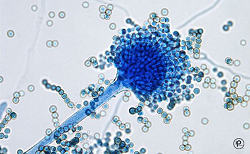To view the original article, click here.
Hello. I am Dr Tom Chiller, deputy chief of the Mycotic Diseases Branch at the Centers for Disease Control and Prevention (CDC). I am pleased to talk to you about antifungal resistance, a topic that needs more attention.
Although antibiotic-resistant bacterial infections are a widely recognized public health threat, much less is known about the burden and consequences of drug-resistant fungal infections. Since the discovery and widespread use of antibacterial medicines in the 1960s and with increasing numbers of high-risk patients, we have seen the emergence and increased rates of serious invasive fungal infections.
Over the past decade, we have made some progress in combating healthcare-associated bacterial infections. Improving care of central venous catheters and a focus on antibiotic stewardship programs have led to decreases in bloodstream infections caused by resistant bacteria, although we still have a ways to go. However, those decreases have resulted in the fungus Candida becoming the most common cause of healthcare-associated bloodstream infections in many hospitals across the United States.[1] The development of a few classes of antifungal agents has given us the ability to treat these invasive infections, but just like bacteria, some fungi have developed resistance and no longer respond to the antifungals that are used to treat them.
Some types of Candida are becoming increasingly resistant to first-line and second-line antifungals—namely, echinocandins and fluconazole. Approximately 7% of all Candida bloodstream isolates tested at CDC are resistant to fluconazole. Most of these isolates are Candida glabrata, 14% of which are resistant.[2,3] The good news is that CDC’s surveillance data indicate that fluconazole resistance has remained fairly constant over the past 20 years.[3,4,5]
In contrast, echinocandin resistance appears to be on the rise, with 3%-5% of C glabrata isolates being resistant to echinocandin.[2] Isolates tested by CDC before 2004 showed no resistance, so this resistance has emerged after the echinocandins became widely used. Today, the prevalence of echinocandin resistance is more than 10% at some hospitals and is continuing to increase.[6,7]
Finally, a growing concern is the presence of multidrug-resistant Candida infections (those that are resistant to both fluconazole and echinocandins), because few treatment options remain, other than amphotericin B. Not surprisingly, there is growing evidence to suggest that patients who have drug-resistant candidemia have worse outcomes than patients who have susceptible infections.[8,9]
Some studies have indicated that antibacterials may also contribute to antifungal resistance; this could occur for a variety of reasons, one of which is that antibacterials reduce bacteria in the gut and create favorable conditions for Candida growth.[10] It’s not yet known whether decreasing the use of all or certain antimicrobial agents can reduce Candida infections, but appropriate use of antibacterials and antifungals is one of the most important factors in fighting drug resistance.
Although most of the resistance that we are concerned about is in Candida species, resistance in other fungi also occurs. I want to highlight the emergence of azole resistance in Aspergillus fumigatus. Since its approval in 2002, the antifungal agent voriconazole has been the primary treatment for invasive aspergillosis. However, more than a decade ago, several countries in Europe began seeing an increasing amount of azole-resistant Aspergillus fumigatus.
Studies in Europe suggest that resistance in Aspergillus may be partially driven by the use of agricultural azoles, which protect crops from fungal diseases.[11,12] Prevalence as high as 30% has been seen in some hospitals in Europe.[13] Patients with these resistant isolates had a much higher mortality—closer to 90%, compared with approximately 40% for patients with susceptible strains.[14] Resistant isolates have been now also identified in the Middle East, Asia, Africa, South America, and most recently in the United States.
The Mycotic Diseases Branch at the CDC is collecting isolates of A fumigatus for US surveillance of resistance. We encourage clinical labs to send samples to CDC. Please refer to the Web resources below for instructions on submitting isolates.
In summary, we encourage hospital executives and infection control staff to:
- Assess antifungal use as part of their antibiotic stewardship programs; and
- Ensure adherence to guidelines for hand hygiene, prevention of catheter-associated infections, and environmental infection control efforts.
We encourage physicians and other hospital staff to:
- Prescribe antifungal medications appropriately;
- Ask their laboratories to routinely determine the species of every Candida sterile body site isolate if it is not reported, and if C glabrata is found, consider ordering antifungal susceptibility testing;
- Document the dose, duration, and indication for every antifungal prescription;
- Be aware of local antifungal resistance patterns; and
- Be active in efforts within your hospital to improve antifungal prescribing.
Medical and Patient education videos
-
Title
Description
-

I have Sarcoidosis, Chronic Pulmonary Aspergillosis (CPA) and a very low CD4 count. I have challenged myself to do a daily vlog for 30 days
Follow me on twitter @StewArmstrong
Here is the link for all of the monthly aspergillosis meetings http://www.nacpatients.org.uk/monthly…
This meeting was for July 2016.
Aspergillus Website: Follow all of our Youtube collections here
-

Stewart Armstrong has chronic pulmonary aspergillosis and has undertaken to record a video of every day of his life for a month in order to help raise awareness of aspergillosis and how it impacts their daily lives.
These videos are interesting for a number of reasons – not least because patients often say that they don’t look unwell so many people don’t understand how serious aspergillosis is. Does Stewart look or act unwell?
See the month of vlogs in the playlist below, or go to Stewart’s YouTube page to watch more of his videos.
-

Global fungal killers and life-threatening infections
Fungi are everywhere, and a few species can cause very serious lethal infections. Fungal infections
-

This panel considers and debates one of the greatest obstacles to food security in many parts of the world: mycotoxin. Aflatoxin is a particularly dangerous mycotoxin produced predominantly by two Aspergillus fungi. It colonizes a variety of important food and feed crops both pre- and post-harvest, including groundnuts, tree nuts, maize, rice, figs and other dried foods, spices, crude vegetable oils and cocoa. Contaminated crops have significant health risks for both humans and animals, having been linked to retarded growth and development (stunting), immunosuppression and liver cancer. The aflatoxin issue has other, complex implications for food security and, by limiting farmers’ access to international markets, can lead to food waste and economic instability.
Panelists:
-John Lamb, Principal Associate, Abt Associates
-Dr. Kitty Cardwell, National Program Leader, USDA-NIFA
-Barbara Stinson, Senior Partner, Meridian Institute; Project Director, Partnership for Aflatoxin Control in Africa
-Moderator: Dr. Howard-Yana Shapiro, Chief Agricultural Officer, Mars, Incorporated -

The role of poorly maintained ventilation ductwork in spreading airborne infections is largely ignored because it is ‘out of sight out of mind’, but recent analysis by healthcare professionals confirms that the risks are increasing.
Ghasson Shabha will identify particular threats in healthcare facilities from dirty ductwork. He also points out that fewer than 5% of building air-conditioning systems have been inspected despite regulations making this mandatory. Dr Shabha will look at how planned cleaning strategies can reduce risks and how hospitals can use 3D building information modelling software to identify ‘infection hotspots’.
The healthcare environment can be described as a reservoir for potentially infective agents which can spread unpredictably in a whole array of ways particularly in ventilation and air-conditioning systems making it difficult to effectively control and manage, for those seeking timely information about the patterns of cross-infection. The severity of the problem has been highlighted extensively over the past decade, as part of wider umbrella of what was known as health care acquired infections (HCAIs). Airborne transmission extends over a wide spectrum, and includes many prevalent agents, inter alia Mycobacterium tuberculosis (TB),nosocomial MRSA, Aspergillus fumigatus, Serratia marcescens, norovirus, and other airborne infection.
Dr Shabha was speaking live from Birmingham and this CIBSE ASHRAE Group (cibseashrae.org) webinar was co-sponsored by the B&ES Ventilation Hygiene Group and the Institute of Healthcare Engineering and Estate Management (IHEEM).
-

Oliphant Science Awards – Year 1 project by Haruki Kurioka, Aleksa Novakovic and Bogdan Novakovic (St Andrew’s Primary School, Adelaide)
Food that we consume daily is rich in good bacteria and fungi. Yogurt, Yakult and Natto (fermented soybeans) are rich in bacteria. Cheeses (e.g. Brie & Blue cheese) and Koji contain fungi Penicillium and Aspergillus, respectively. Many Japanese and continental seasonings and dishes can be prepared with those products. Many kids and their parents don’t know much about good bacteria and fungi. First year students are here to tell us their story. Enjoy it!




